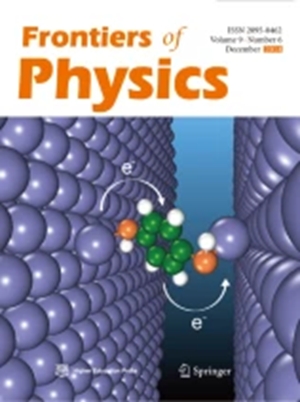社论:多物理场耦合过程中的移动边界问题
IF 6.5
2区 物理与天体物理
Q1 PHYSICS, MULTIDISCIPLINARY
引用次数: 0
摘要
在裂纹扩展、流固耦合、可变形多孔材料的流动、材料成形过程等诸多问题中,材料/结构的边界或不同材料/结构之间的界面会因相关组分的原位响应和环境因素而发生变化。这类问题也被称为移动边界问题,而随时间变化的边界对这类问题的数值模拟以及控制移动边界演化的内在机制的研究提出了重大挑战。运动边界引起的严重非线性需要发展先进的数值算法,而运动边界问题中力学、热、电甚至化学反应等多物理场行为的相互作用需要研究多物理场建模方法。本课题“多物理场耦合过程中的移动边界问题”收集了对多物理场过程移动边界问题进行实验、数值和理论研究的16篇论文。入选论文以“多物理场耦合过程中的移动边界问题”为重点,在研究对象、研究方法和研究成果方面表现出良好的多样性。一些贡献者在裂缝建模方面取得了有价值的成果。例如,Ma等人利用离散元法建立了含有随机圆形缺陷的多孔混凝土的数值模型,研究了缺陷的孔隙度或尺寸均匀性对力学行为、裂纹演化和声发射(AE)响应的影响。他们的发现有助于理解多孔混凝土裂纹扩展的微观机制。为了加速裂缝数值模拟,Liu等人采用了分解相场和物理长度尺度的退化函数来降低大型结构中的网格密度。通过将Drucker-Prager破坏面引入相场模型,表征岩石中裂缝的拉压不对称性,可以较准确、高效地捕捉岩石材料中的裂纹扩展路径。Lian等人提出了一种新的框架来有效地模拟脆性材料中的裂纹扩展,而不是使用传统的数值方法,其中偏微分OPEN ACCESS本文章由计算机程序翻译,如有差异,请以英文原文为准。
Editorial: Moving boundary problems in multi-physics coupling processes
In many problems such as propagation of crack, fluid-structure interaction, flow in deformable porous materials, material forming process and so on, the boundary of material/ structure or the interface between different materials/structures varies depending on the insitu responses of associating components and environmental factors. Such problems are also named as moving boundary problems, and the time-dependent boundary poses significant challenges to the numerical modelling of such problems as well as the study of inherent mechanisms dominating the evolution of moving boundaries. Severe nonlinearity caused by the moving boundary requires development of advanced numerical algorithms, while interaction of multi-physics behaviors in moving boundary problems such as mechanical, thermal, electrical and even chemical response, necessitates research of multi-physical modelling methodologies. This Research Topic “Moving Boundary Problems in Multi-physics Coupling Processes” collects 16 papers contributing to the experimental, numerical and theoretical research on moving boundary problems of multi-physics processes. While focusing on “Moving Boundary Problems in Multi-physics Coupling Processes,” the selected papers show a good diversity in terms of their research objects, methods and findings. Some contributors have obtained valuable achievements on modelling of cracks. For instance, Ma et al. used discrete element method to establish a numerical model of porous concrete with random circular defects inside, to study the influence of the porosity or size homogeneity of the defects on the mechanical behavior, crack evolution, and acoustic emission (AE) responses. Their findings can aim the understanding of micro-scale mechanism of crack propagation in porous concrete. To accelerate the numerical simulations of fracture, Liu et al. employed degradation function that decouples the phase-field and physical length scales, to reduce the mesh density in large structures. By incorporating the Drucker-Prager failure surface into the phase field model to characterize the tension-compression asymmetry of fractures in rocks, they can capture the crack propagation path in rock materials with a good accuracy and efficiency. Instead of using conventional numerical methods, Lian et al. proposed a novel framework for efficient simulation of crack propagation in brittle materials, whereby the partial differential OPEN ACCESS
求助全文
通过发布文献求助,成功后即可免费获取论文全文。
去求助
来源期刊

Frontiers of Physics
PHYSICS, MULTIDISCIPLINARY-
CiteScore
9.20
自引率
9.30%
发文量
898
审稿时长
6-12 weeks
期刊介绍:
Frontiers of Physics is an international peer-reviewed journal dedicated to showcasing the latest advancements and significant progress in various research areas within the field of physics. The journal's scope is broad, covering a range of topics that include:
Quantum computation and quantum information
Atomic, molecular, and optical physics
Condensed matter physics, material sciences, and interdisciplinary research
Particle, nuclear physics, astrophysics, and cosmology
The journal's mission is to highlight frontier achievements, hot topics, and cross-disciplinary points in physics, facilitating communication and idea exchange among physicists both in China and internationally. It serves as a platform for researchers to share their findings and insights, fostering collaboration and innovation across different areas of physics.
 求助内容:
求助内容: 应助结果提醒方式:
应助结果提醒方式:


